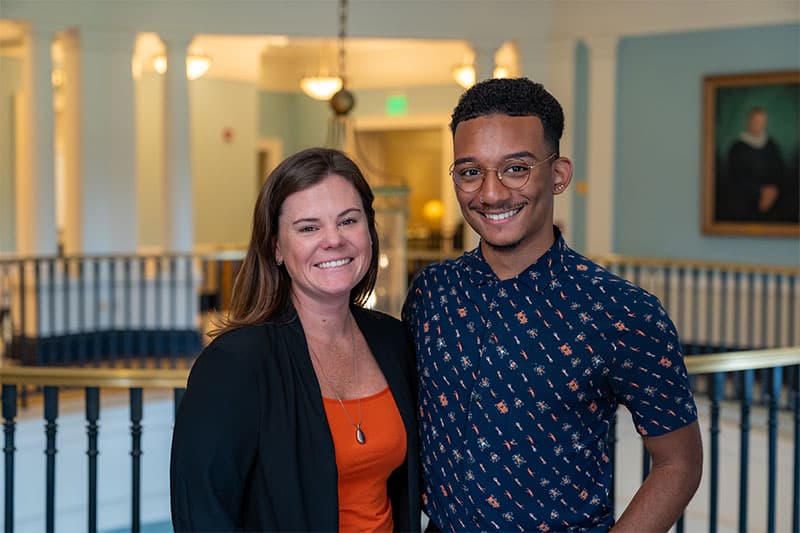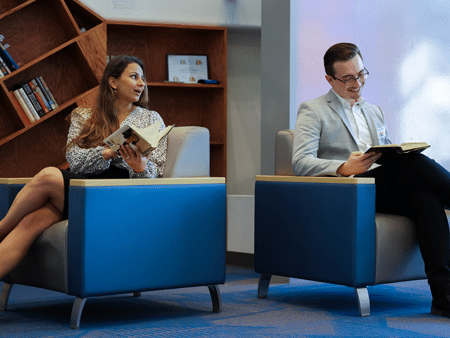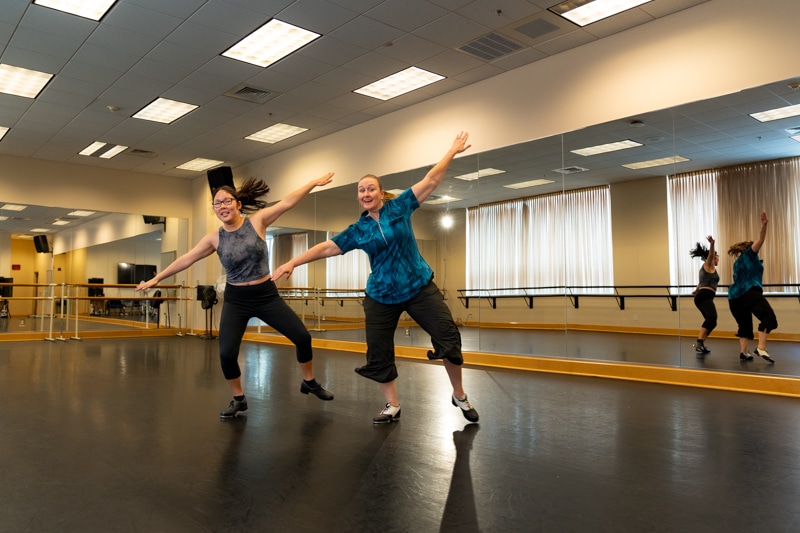
Student researches public opinion about Civil War monuments
Dayman Parrish came to Christopher Newport to discover his passion and true calling.
He found it in the study of race, civil rights and public opinion, and how all three relate to each other. Dr. Brooke Covington helped him make the connections.
Parrish, ‘24 Political Science, plans to go to law school, intent on making the world a place that is fairer, kinder and where history is examined under a more revealing light.
His future came into focus when he took Covington’s class: Introduction of Civic Engagement and Social Justice. The work Parrish did with Covington, who teaches in the English Department and is academic director of the Center for Community Engagement, strongly resonated with him and shifted both his perspective on the world and his career trajectory.
“It inspired me so much that I decided to take up minors in civic engagement and social justice and do research with her,” Parrish said. “I asked her if she had any opportunities and she said, ‘Well, I’m doing this thing.’”
That “thing” morphed into Parrish becoming a Summer Scholar, an opportunity to immerse himself in a research project for Covington that involved the study of how critical race theory, an interdisciplinary field of thought committed to analyzing how racism is embedded in social institutions, tied into public dialogue and opinion surrounding the fate of a Confederate monument in Isle of Wight County.
Summer Scholars is a program unique to Christopher Newport that encourages students to embrace research projects. It is an eight-week, in-residence program that brings students and faculty together to work collaboratively to answer a research question. Scholars receive a housing allowance and stipend.
“The summer before Dayman came into my class, I had a different Summer Scholar working on this project, which is focused on the Confederate monument in Isle of Wight and a public hearing that was held to determine what should happen to it,” Covington said. “I shared some of that work with the class because I always want to bring my research into the classroom, especially when the research includes students. Dayman was a student in the class and we were learning about critical race theory. The research was a really nice example of how to teach critical race theory and how to apply it to a real case study. Dayman came up after the class and said, ‘I want to be involved.’”
Parrish, also a Bonner Service Scholar, eagerly jumped into Covington’s research, analyzing comments made at a public hearing that focused on whether to keep the monument as it was or to remove it from the public space. Parrish and Covington looked for evidence of counter storytelling in people’s commentary, which would help explain their stance of whether they were pro- or anti-monument.
“Counter storytelling is countering a dominant narrative that relates to the statue. If people said, ‘Oh, it should be kept. It’s a preservation of history. It’s a tomb for fallen soldiers.’ That would be considered a stock narrative. The counter-narrative would be that this is a Jim Crow scare tactic that historically has kept people of color from feeling welcomed, represented, or treated fairly at the courthouse,” Covington said.
“The monument itself was erected in 1905. We’re looking at years after the Civil War. We’ve talked a lot about the end goal of this work and that this is something that is happening all across the United States. We want to try to understand the arguments being made on both sides,” she said. “We’re just hoping to shed light on all of the ‘whys’ and then get folks to read that, hear it and maybe change perspectives in a way that promotes social justice for all. That’s the goal, to make the world a better place.”
The Isle of Wight Board of Supervisors, after the hearings, ultimately voted to remove the monument from in front of the county courthouse, where it had stood for more than 100 years. It was officially handed over to county residents Volpe Boykin and Jennifer Boykin to be placed on their property.
Covington said critical race theory (CRT) “was the lens we brought to this project because we really wanted to honor and listen to BIPOC (Black, Indigenous, and People of Color) perspectives on how Confederate monuments continue to evoke harm and sow division in communities. Racism was a central theme mentioned again and again during the public hearing—by citizens from all different viewpoints.
“We felt CRT was an appropriate and important lens to bring to this data set, especially given the common misconceptions about CRT and its aims. Our goal was to show how CRT can be applied and how this school of thought can help us all be better listeners, better critical thinkers, and better at respectful disagreement,” she said.
The research conducted by Parrish and Covington’s former Summer Scholar, Julianne Bieron ’22, and done in partnership with Chief Rosa Holmes Turner, chief of Warraskoyack Tribe in Isle of Wight County, formed the basis of a recently published journal article.
Parrish has been so moved by the research and his work with Covington, that he has decided to use it as a foundation for his career goals. He hopes to continue his work advancing social justice issues as a law student, and one day as an attorney.
“I’m a Black male, so that’s been an interesting experience to have in America. I’m a Black gay male, so that’s another experience to have in America. But this work specifically connects to me in the sense of how the root of critical race theory actually started and that relates to me and my future life, because it started in perspectives of looking at how race is effective on law. Law is what I eat, sleep and breathe. It’s connected to what I want to do as a lawyer because I want to be a part of that kind of conversation where I am helping with civil rights.”
Being a Summer Scholar and achieving success in moving Covington’s research forward has not only expanded Parrish’s worldview, it has also amplified his love for Christopher Newport.
“You know, a lot of people asked me why I chose to go here,” he said. “I feel proud to say that I want to make a difference in the world. And I wanted to go somewhere that wasn’t going to be ‘traditional’ for me or someone who looks like me.
“I have found my people here. I have found Dr. Covington, who I can share my opinions with and be able to have that safe space where I can just be. You find your people here and you find professors you can lean on. You find the interest that you can lean into. And I wouldn’t trade it for anything else. I feel like being here has provided me with an opportunity I am so lucky to have.”
Written by: Kelli Caplan for Christopher Newport University; used with permission. Find the original article here



